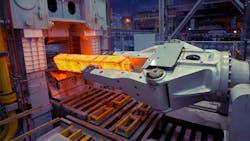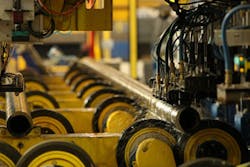Steelmaker Gets In Line, and Becomes a Forger
The Timken Co. is well known as a supplier of steel products to forgers. Now, it’s joining the group. The company’s Faircrest Steel plant in Canton, OH, is the site of North America’s first in-line forging press, an open-die operation in the service of higher steel volumes and better quality steel products.
Faircrest was developed more than two decades ago as a greenfield operation, with a capacity of about 500,000 tons/year. It produces large-dimension engineered steel long products, poured as ingots and rolled to bars and blooms. “Over the past 20 years or so, we’ve been able to increase our capacity from to over 1 million tons/year,” explained Tom Moline, vice president for steel manufacturing at Timken, “and we’ve done that without making any significant capital investment in the plant, mostly through continuous improvement projects.
“But, what we’ve seen recently is that there is an increase in demand for the types of clean, highly engineered steel products that we make,” he continued, “particularly in the industrial segment, and in the oil-and-gas segment for various applications.”
Thus, Timken initiated a $270-million effort to add steelmaking capacity, and to do so in ways that would ensure the quality of the steel would be maintained and the efficiency of the operation would be improved.
The keystone of the expansion will be a four-strand, vertical continuous caster producing “jumbo” blooms. It’s under construction now, for completion next year. “It will allow us to continuously cast products, as opposed to bottom-pouring ingots, which is what we do today,” Moline explained, “and still get the same high quality and cleanliness that we get out of our bottom-poured products. But, we’ll gain a significant yield and capacity advantage in the casting process. That’s going to give us about 125,000 additional tons per year of steel capacity.” Ingot pouring will continue, on a reduced scale.
Along with the caster, Timken is adding a second ladle refining station. As casting capacity increases, the second ladle station will mean that Faircrest’s electric arc furnace can melt heats faster, thereby adding another 40,000 tons/year of capacity.
But, it’s the $35-million in-line forge press that is already showing the rewards after nearly two years of capital investment.
One-of-a-Kind Process
The automated open-die system is the only operation of its kind in North America, conceived as a sizing stage in Timken’s bar rolling process. It was designed by Mitsubishi Nagasaki Machinery Mfg. Co. Ltd., installed last year, and started up in December.
Aside from the process advantages, the purpose of in-line forging is to convert heated, special bar-quality steel ingots weighing up to seven tons (and measuring 7 feet long and 28 inches in diameter) into 22-in. blooms. Those blooms are rolled into bars with more reliable “center soundness” across a wider cross section of SBQ products.
Once the new caster is operating, the forge press will handle both con-cast blooms and the ingots that Faircrest will continue to pour (for applications where that production route is preferred.)
“Pressing” the blooms (or ingots) prior to rolling allows the steelmaker to ‘sound up’ the centers, as Moline explained, creating large-dimension products with solid cross-sections. He noted that the plant’s previous limit for a “sound center” was about 8-in. in cross section. “With the new forge-press we can get up to around 16-in. with a guaranteed sound center.”
“The forge press opens new market spaces for customers and Timken,” according to Rich Kyle, Timken’s Steel group president, “providing particular value where performance in extreme operating conditions is of critical importance.
“Adding this forging step prior to rolling further improves bar soundness,” Kyle explained. “The forge press also contributes substantially to our long-term competitiveness by bringing greater differentiation and expanded capacity for high-quality Timken products to customers worldwide.”
Rolling Along
According to Tom Moline, the installation and start-up last year, and the initial months of operation have been smooth.
“We wanted something that we could put in line with our rolling process,” he detailed, pointing out how increasing the volume of steel processed from the melt shop and through the caster required a production step that would allow the rolling mill to operate faster. The in-line forge press accelerates the sequence formerly required to break down ingots for finish rolling.
“We wanted something that we knew could provide some efficiencies with our rolling operation,” Moline detailed. “By taking those ingots and pressing them first we actually reduce the number of roll-pass sequences that we have to perform in the mill, which gives us a capacity ‘kick,’ and as we’re healing up the center of the ingots we’re also healing up the ends, which gives us a modest yield increase as well.”
More telling than the start-up effort has been the market’s response. “We can now go to market with these guaranteed sound centers and large cross sections that most of the industry would have to make from ingots, forged to size,” Moline explained. “They don’t have the benefit of the tight size control and shape control that we get from our rolling operations by forging and then rolling. The products that we’ve delivered to the market have been very well received by our customers.”

